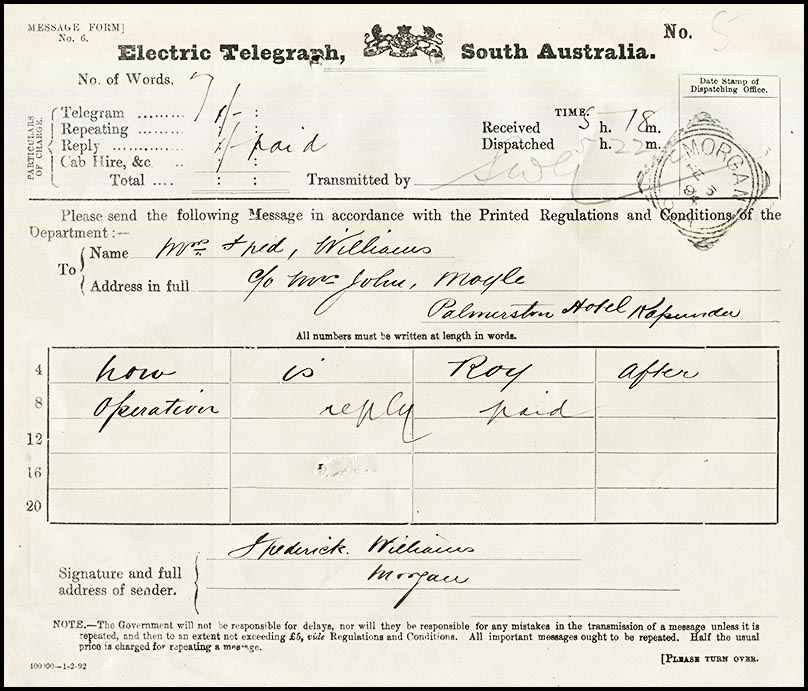Instructional marking - REPLY PAID.
- Australia 1901-1988
- New South Wales
- Queensland
- South Australia
- Tasmania
- Victoria
- Western Australia
- International
- Special aspects
It is not known when the Reply Paid facility was introduced into South Australia. Certainly the description at the end of this page shows it was in use by the end of 1873.
At the Inter-Colonial Postal Conference held in Sydney on 8 March 1891, the sub-committee of the Heads of Departments agreed that the following should be part of the revisions for the Telegraphic Regulations:
"As a general rule all messages must be prepaid, except in cases of replies to messages on which the words "reply paid" have been written, or where special arrangements have been made for payment by the receiver, but in all cases the sender will be held responsible for the cost of the message should payment be refused by the addressee. Names and addresses will be counted as forming part of the message".
 SC-TO-3C transmission form for a 7 word message sent from Morgan to Kapunda on 3 February 1894. The 1/- cost for sending a telegram within South Australia was 1/- which was paid and added to the annotation in the top left as too was 1/- for a reply of up to 10 words. |
On 27 October 1877, the South Australian Chronicle published a note from the Telegraph Office regarding Reply Paid telegrams to New Zealand:
"The following notice was posted outside the Telegraph Office on Wednesday afternoon, October 24:
In future persons sending messages to New Zealand can, if they wish, pay for replies at the time of depositing their telegram, but it will be necessary that they should include the words "reply paid" (those words being counted and charged for), and deposit a sum sufficient to pay for a reply of 20 words, undertaking to pay any balance that may be chargeable should the answer be longer. Any over-payment will be returned when the reply is delivered. Should no reply be received, the deposit will be returned when the office to which the message was addressed has been advised that application for refund has been made".
An interesting use of the REPLY PAID annotation - for which, unfortunately, the telegrams are now probably lost - was reported in the Border Watch on 3 December 1873:
POISON PLANTS.
Some months ago we published an account of the death of a number of sheep on the property of Mr. R.D.Renfrey of Craik Farm which it was supposed had been caused by their eating a species of night shade, technically known as Solanuia Nigrum. The notice attracted the attention of the Surveyor-General, Mr. Goyder, and the following telegrams - kindly placed at our disposal by that gentleman - have passed between him and the well-known botanist, Baron von Mueller (and also refer to another reference) on the subject:
- Copy of telegram from Surveyor-General to Baron von Mueller. 24. 11. 73.
It is stated that numerous deaths of sheep in South-East are caused by the plant known as Solanum Nigrum. Please say if, and in what stages, that plant is poisonous, Reply paid.
- Copy of telegram from Baron von Mueller to Surveyor-General. 26. 11. 73.
Herb of Solanum Nigrum contains solanus and other poisonous principles in all stages of growth - berries when ripe often not poisonous - plant annual - easily extirpated - not a native. Perhaps death of sheep by Lobelia or other herbs also.
- Copy of telegram from Surveyor-General to Baron von Mueller. 26. 11 73.
Thank you very much. Is it desirable to include Solanum Nigrum amongst prescribed plants? It is spreading rapidly in South. Reply paid.
- Copy of telegram from Baron von Mueller to Surveyor-General. Herb Solanum not included among plants to be eradicated, but thistles only. Perhaps best to direct merely public attention to it and Lobelia (native tobacco plant)".